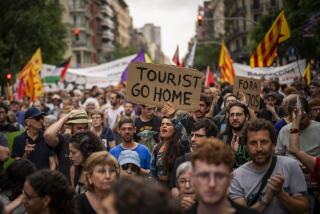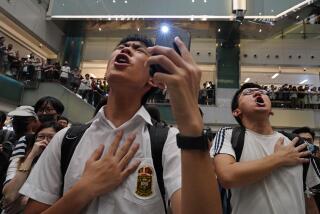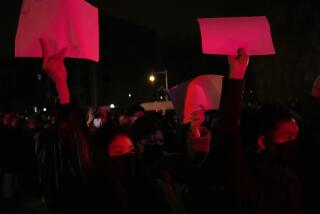Is it safe to travel to Hong Kong?
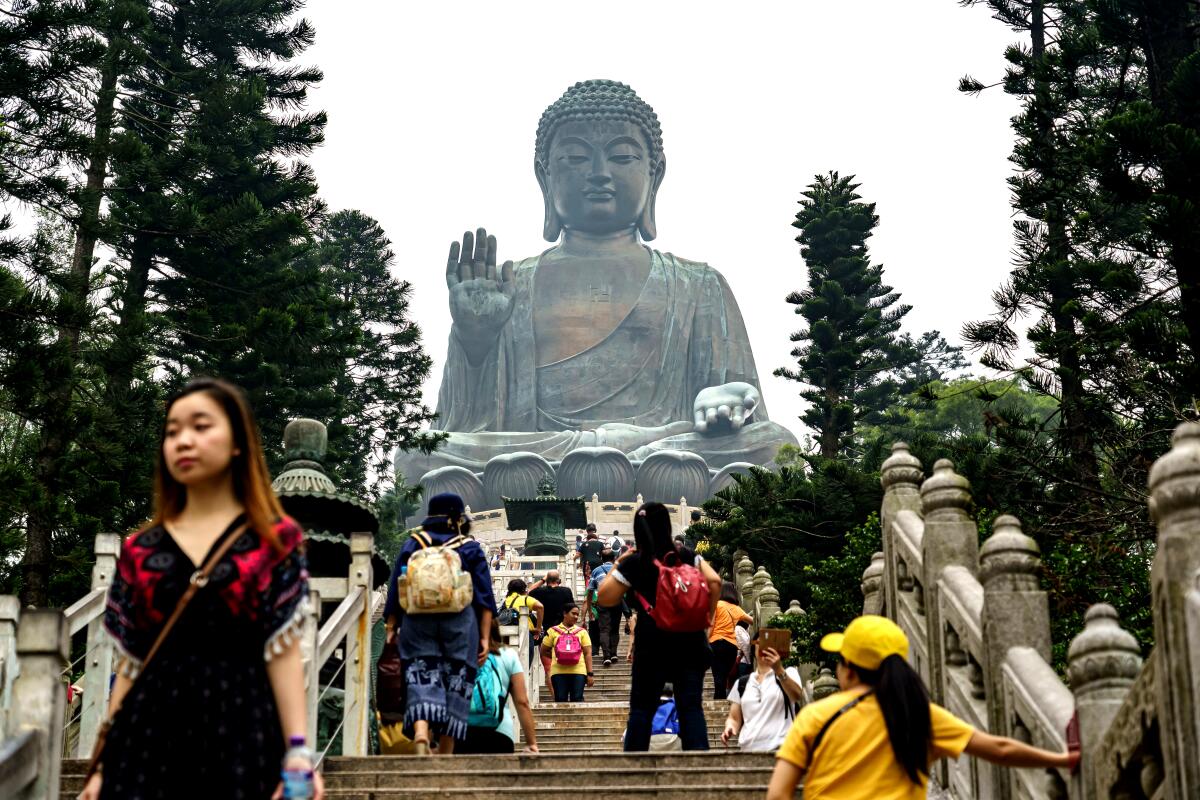
HONG KONG â Images of riot police lobbing tear-gas canisters into angry crowds played on the news. Activists were blasted with water cannons and carted away. Thousands of protesters filled the streets, demanding greater autonomy from China.
A proposed bill, since withdrawn, that would have allowed extradition of criminal suspects to mainland China ignited the dissent. What started as peaceful marches had escalated into violent clashes between citizens and the police. The Chinese government has threatened severe consequences.
Into this, I decided to take my family.
The almost daily news of dissent has impacted tourism: There was a 39.1% drop in visitor arrivals in August over the same month a year earlier, according to the Hong Kong Immigration Department. People in the rest of the world declined to visit as increasingly contentious conflicts between pro-democracy citizens and the authorities took place.
But I wasnât one of them.
Hong Kong is my home. I was born here when it was part of the British empire and lived here, after the handover to China in 1997, until I moved to Los Angeles in 2000.
My family has been in Hong Kong for three generations, my great-grandfather setting off from India in the early 1900s to establish trading outposts in Southeast Asia. My father started working in the Hong Kong branch when he was 18. He never left. He is about to turn 90.
That was one reason I was compelled to return in September, civil unrest notwithstanding. My sons, 14 and 17, had not seen their grandparents in 2½ years. My dad had recently been in the hospital. My mother had just turned 80. We had a brief window before my older son resumed his studies at UCLA.
Sometimes family trips just canât be put off.
Given the decline in Hong Kong tourism, airfares and hotel rates were reasonable. The chant of âWhat about the riots?â from people in Los Angeles fell on my deaf ears.
Some insularity comes with being familiar with a place, so even when it is troubled, as Hong Kong is, it still feels safe. I have never known Hong Kong to be anything else.
A woman can walk home at 2 a.m. and not fear for her life. People donât carry guns in this city where gun laws are extremely tight. (There were 120.5 civilian-held firearms per 100 people in the U.S. In Hong Kong, that number is 3.6., according to a 2017 report from the Geneva-based research group Small Arms Survey.
Before booking my tickets, I called a British journalist friend in Hong Kong who not only follows news of the protests but has marched alongside them in a mix of curiosity and solidarity. She said with some exasperation, âFor heavenâs sake, nobody has died. Youâre safer here now than on any day in America.â I found it hard to argue with that.
I checked travel advisories and didnât discover anything that would cause me to cancel. Because there had been showdowns at Hong Kong International Airport leading to flight cancellations, I made sure the travel insurance I bought covered civil disturbance.
I knew that if there was any real threat, my parents and my brother and his family, who also live here, would say, âDonât come.â
They never did.
Tourist areas affected
The key to visiting Hong Kong now â and I would again, despite the escalation and frequency of the clashes â is planning. Things have taken a turn for the worse; Jimmy Sham, head of the Civil Human Rights Front, the de facto leader of the uprising, recently was attacked. The mood in the city, my friends say, is tense.
Still, Mondays to Fridays, itâs mostly business as usual in this hyper-efficient and industrious city. With rare exception, protests donât take place during the week. Stand in Central, the financial district, at the intersection of Queenâs Road and DâAguilar Street at 1 p.m. on a weekday and watch the office buildings disgorge thousands of people out to grab lunch. It was always that way.
I thought people would stay in, given the circumstances. They did not. The places that locals frequent, such as the Chili Club, a Thai restaurant Iâve been patronizing for more than 20 years because of its legendary papaya salad, are still busy.
Where I did see a difference was in areas that tourists frequent. On previous trips to Hong Kong, we would wait at least an hour to board the Peak Tram, the funicular railway that for a few dollars takes you from Central adjacent up a steep hillside to the Peak, the tallest point on Hong Kong Island, where people go for the views.
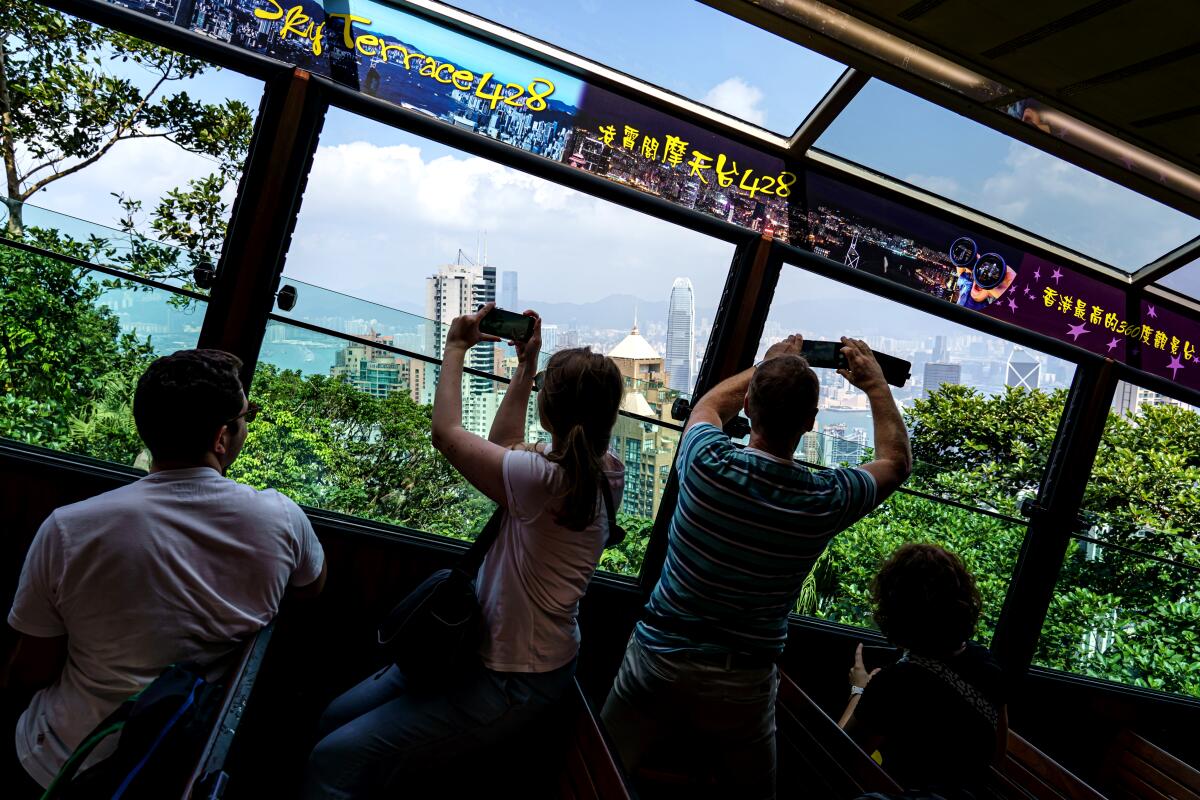
The harbor has shrunk, the buildings grow taller, but the impact of the view remains, whether on a crisp, sunny day in April or through a veil of mist in frosty (for Hong Kong) February. Itâs not surprising people wait an hour or more to see it.
When we drove past the Central boarding station on this visit, however, there was no line.
Itâs quiet at tourist havens such as Hong Kong Disneyland, the marine-based theme park Ocean Park and Tian Tan Buddha, a 112-foot-tall bronze statue of Buddha, at Ngong Ping on Hong Kongâs Lantau Island, accessed by a cable car ride over lush green mountains.
These were places we waited in long lines for rides or refreshments when I took my young children. We didnât visit them this time, despite the exhortations of friends who said, âThereâs nobody there! You should go!â
The decrease in tourism was apparent in other ways. On previous trips, I always set aside an afternoon for the Mongkok Ladies Market, bazaar-like streets jammed with stalls selling knockoff brand-name sneakers, pretty sets of chopsticks, teacups and more.
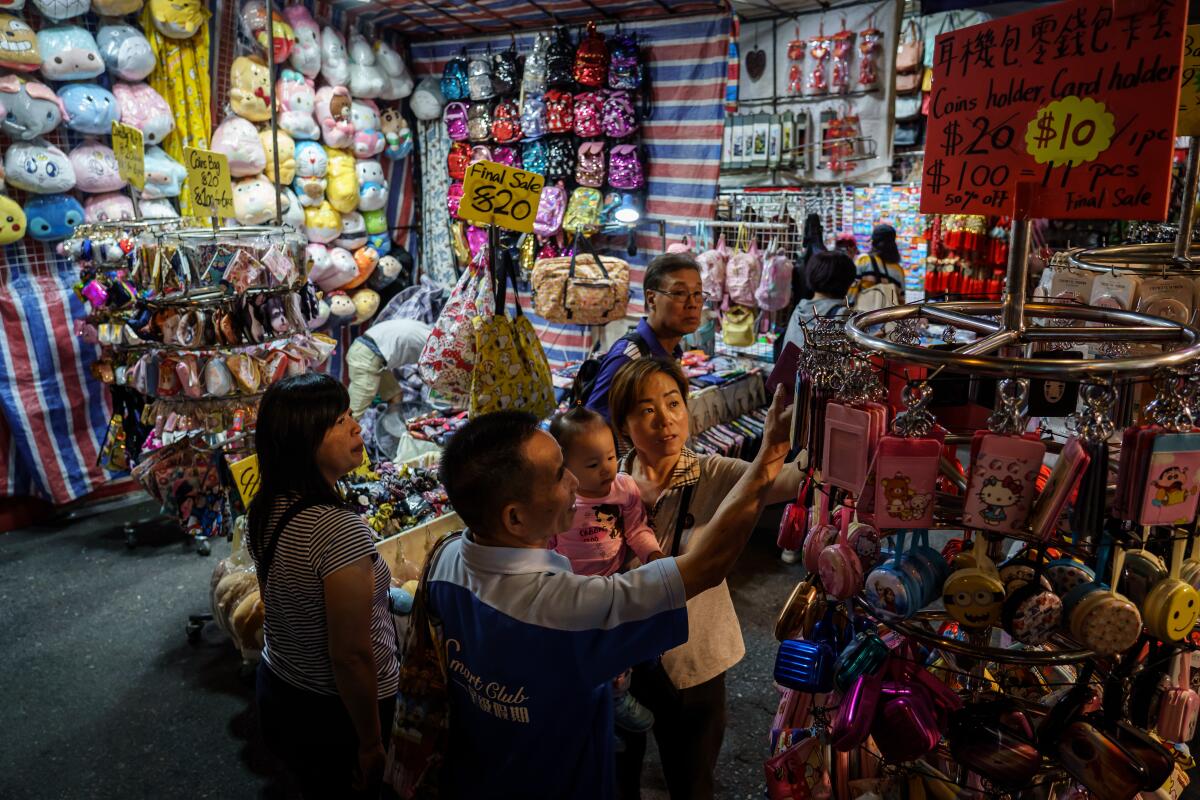
Bargaining is a hoot, with sellers shouting their best offers as customers walk away: â$100! OK, for you $80! OK, final price $60!â The area is typically packed with tourists. In the past, itâs been hard to move.
This time, Mongkok Ladies Market was almost empty. The contrast between the streets within the market, and the streets outside it, was marked. Mongkok, in Kowloon, across Victoria Harbor from Hong Kong Island, is, according to Guinness World Records, the busiest district in the world, with about 340,000 people living per square mile.
I reckon they were all out that Thursday afternoon. We waited 15 minutes for a $2 glass of fresh watermelon juice and gai daan jai â Cantonese egg waffles that are a typical street snack. But as we approached the actual market, the crowds thinned. Locals donât frequent it unless theyâre with out-of-town visitors.
High alert
On the weekends, however, Hong Kong residents are on high alert. Protests can start on a Friday night and stretch to Sunday afternoon. They take place all over Hong Kong Island, Kowloon and the New Territories, which are on Hong Kongâs outlying islands.
Still, Hong Kong-style efficiency is apparent even in chaos. Protest groups let the public know where they will be, which makes it easy to avoid those areas. WhatsApp groups disseminate minute-by-minute information with photos: Stay away from Kowloon Tong; Pacific Place is closed; there are riot police gathering in Yaumatei.
The closest we came to seeing a protest was on a Friday evening outside our hotel in the west end of Central, and it was small-scale. About 30 students from the University of Hong Kong had gathered to talk to passersby and to invite them to write a few words on a pillar already emblazoned with âStay Strong, Hong Kongâ types of sentiments.
Most people who donât participate in the protests see them as a hassle rather than as something to fear. They support protestersâ demands for greater autonomy from China. My friends here donât feel endangered, just inconvenienced. The Mass Transit Railway subway system â a marvel of public transportation â used to stay open till 1 a.m. It now closes at 8 p.m., but even that changes day to day depending on the station.
The Airport Express, a sophisticated high-speed train that travels from the airportâs arrival hall into Central in 23 minutes for about $15, no longer stops along the way. Shops that used to be open until 10 p.m. now close in the middle of the day. The neighborhood 7-Eleven is now dark at 4 p.m. Luxury boutiques are struggling. I used to see lines of mainland Chinese shoppers outside Chanel and Louis Vuitton. They are no longer there.
So should you visit?
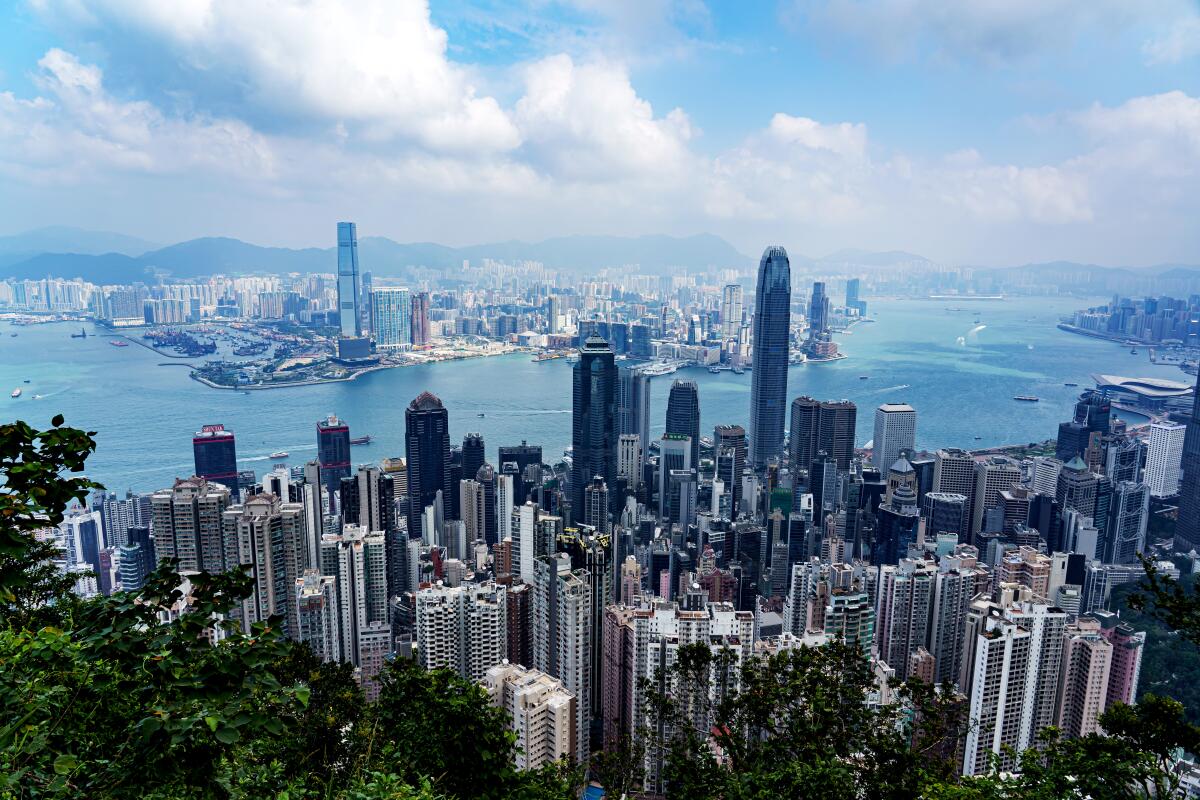
According to the U.S. State Department, Hong Kong is a Level 2 destination, which means âExercise Increased Caution.â The highest is Level 4: Do Not Travel.
âThe important thing is for people to avoid areas where protests are happening,â said Brendan OâReilly, intelligence analyst for Asia at the travel risk management firm WorldAware. âEspecially anything near a government facility, a police station or an MTR station where protesters gather. As long as people avoid those venues, Hong Kong as a whole is still typically safe.â
Experts do caution that travel insurance providers may not cover losses incurred as a result of the protests, so if you do go, check those details in your insurance policy carefully.
Some also advise suspending leisure travel. âI would say no,â said Mike OâRourke, chief executive of global security consultancy Advanced Operational Concepts, who has spent much of the year in Hong Kong. âOn recent weekends prime shopping areas have been targeted by the protesters.â Tourists, he said, will be impacted by vandalism at MTR stations, including fires, leading to their closure. âTourists depend heavily on public transport here.â
But staying away, some said, sends the wrong message.
âI think itâs really important for people to continue to shine a light on Hong Kong, and clearly travel is a part of that,â said Joel Rubin, former deputy assistant secretary of state and adjunct faculty member at Carnegie Mellon Universityâs Heinz College. âI think if people had planned to travel to Hong Kong, they should travel. For those who care about Hong Kong and whether its democracy movement is going to persist, the last thing they should do is avoid it.â
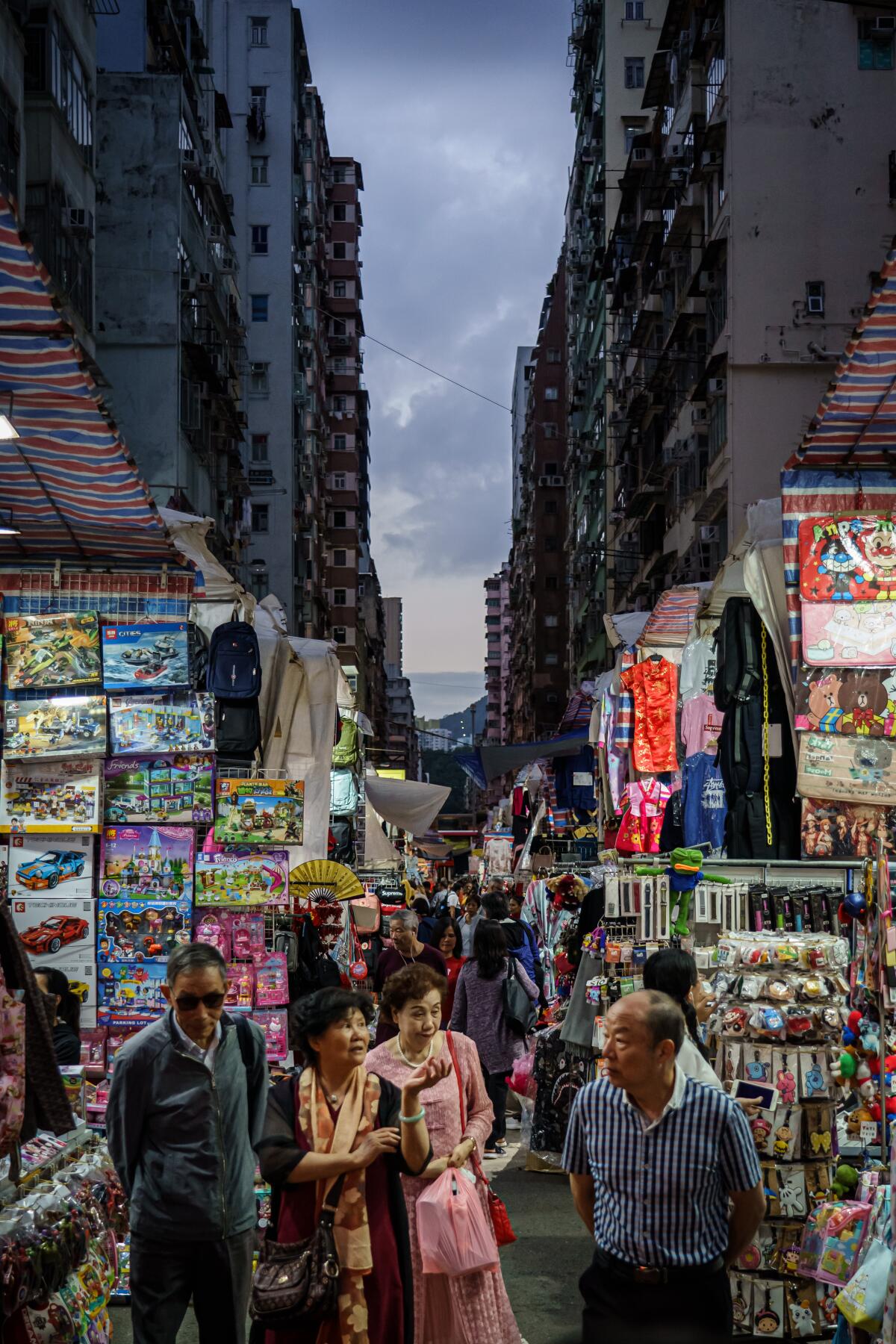
Hong Kong â its unaffordable housing notwithstanding â does try to take care of its people. It built the worldâs longest escalator so those who live in the hilly areas called the Mid-Levels can ride for free to Central. Hong Kong residents can see a doctor for $6 at a government clinic or be admitted to a hospital for $15 a day. Anyone 65 or older gets $165 every month from the government for what is called âfruit moneyâ â essentially an âold-age allowance.â Some years ago, on the back of a budget surplus, every permanent resident received about $800 in a kind of âshare the wealthâ initiative.
That sort of consideration still prevails even in the face of the dissent.
We were flying out of Hong Kong on a Sunday to return to Los Angeles. Weâd been told to get to the airport earlier than usual as protests were being planned near there and roads might be closed.
We saw riot police and vans lining the approach to the airport. Queues had formed outside the departure terminal as passengers were being asked to show proof of travel.
Outside the terminal, all the luggage carts, destroyed in previous skirmishes with the police, had been removed. We had eight pieces of luggage to check. We needed carts. I found an airport staffer who said, with a smile, âDonât worry.â
He found two colleagues, grabbed carts from inside, loaded our luggage and patiently waited while we went through security. He apologized for the hassle. He wished us safe travels and said, âWelcome back soon,â the smile never leaving his face.
If you go
- Check for updates on Facebookâs BeWater HK page (bit.ly/bewaterhk), where schedules of upcoming protests are routinely posted.
- The South China Morning Post (scmp.com) has a live blog with continuing updates.
- On Twitter, @mtrupdate posts events at the cityâs MTR stations, which can close suddenly.
- Avoid hotels in Wan Chai, Causeway Bay, Pacific Place and many parts of Kowloon. Central, Sheung Wan and Kennedy Town are better options.
More to Read
Sign up for The Wild
Weâll help you find the best places to hike, bike and run, as well as the perfect silent spots for meditation and yoga.
You may occasionally receive promotional content from the Los Angeles Times.
